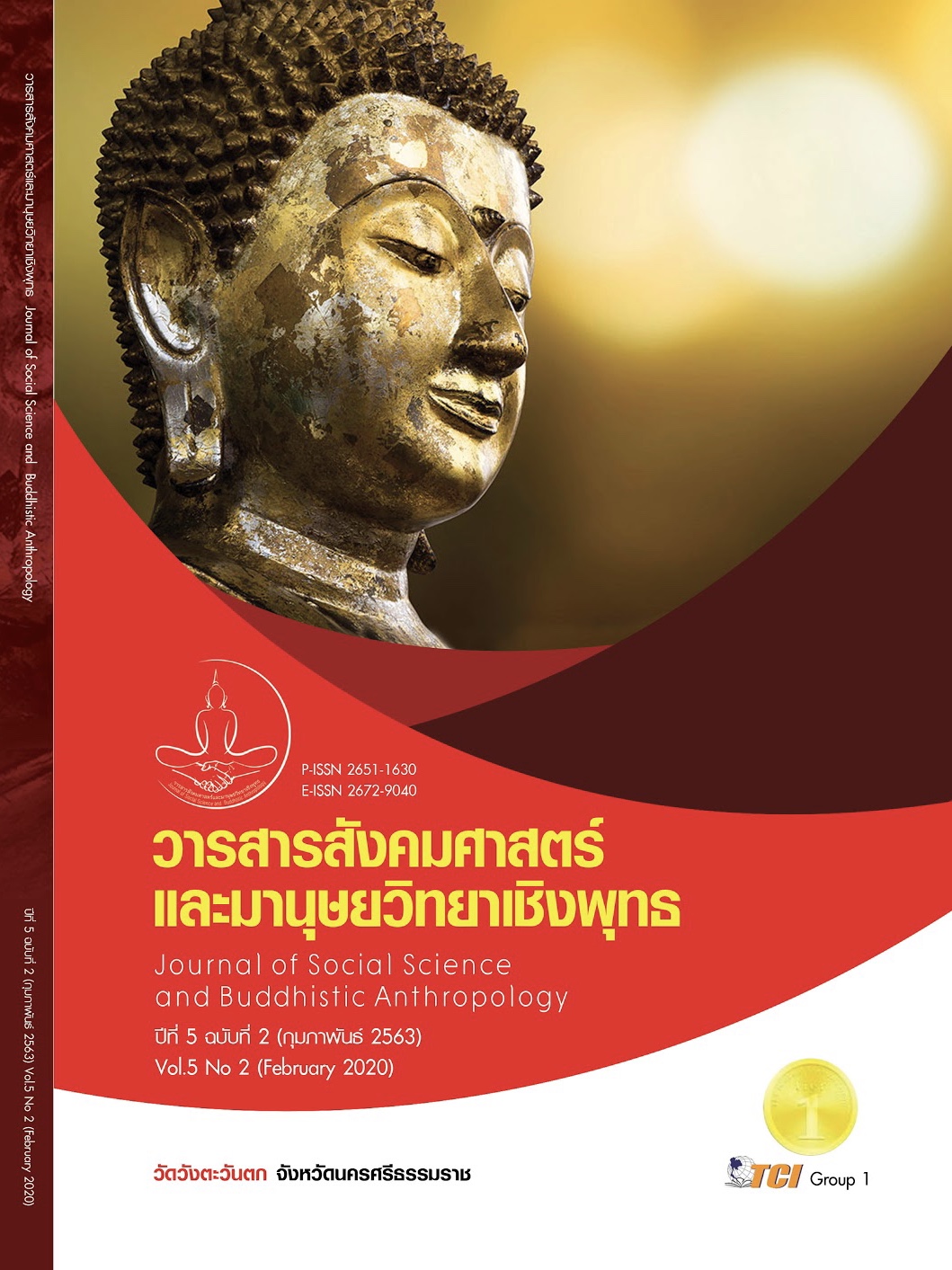AN APPLICATION OF IDDHIPADA DHAMMA IN WORK PERFORMANCE OF PERSONNEL IN CHA-UAT DISTRICT OFFICE NAKHON SI THAMMARAT PROVINCE
Keywords:
Itthbaht Dharma, Operations, Personnel, Cha-Uat District OfficeAbstract
The objectives of this research were 1) to study the application of the itthdaht Dhamma Practice to the personnel performance to Cha-uat District Office, Cha-uat District, Nakhon Si Thammarat Province. 2) In order to compare the utilization of itthdaht Dhamma Practice to the work of personnel at Cha-uat District, Cha-uat District, Nakhon Si Thammarat Province, which have different gender, age, education level, marital status and monthly income. 3) to study the suggestions on the guidelines for promoting the application of the itthdaht Dhamma Practice to the personnel of Cha-uat District Office, Cha-uat District, Nakhon Si Thammarat Province, by Using quantitative research data were collected by questionnaires. The population consisted of 410 personnel. Specified the sample group using the schedule of Krejeic and Morgan. The sample size was 196 people. The data analysis was done using percentage, mean, standard deviation and finding. T-test and F-test.
The results of the research showed that 1) The results of the study the application of the itthdaht Dhamma Practice to the work of personnel overall, in the 4 aspects, was at the high level ( = 3.97) 2) The Comparative results of classified by gender, age, education level, marital status, and monthly income, found that the overall was not significantly different at the .05 level. 3) Suggestions on ways to promote the application of itthdaht Dhamma Practice to the operations of the personnel. In the area of perseverance, procurement of modern equipment in Chitta to have concentration training for personnel to work with Do not concentrate on the scrutiny of time to suit the task assigned.
References
กนกรภัส วงษ์ภากนกภณ. (2558). การปฏิบัติงานตามหลักอิทธิบาทธรรมของบุคลากรองค์การบริหารส่วนตำบลในอำเภอบางปลาม้า จังหวัดสุพรรณบุรี. ใน วิทยานิพนธ์พุทธศาสตรมหาบัณฑิต สาขาวิชารัฐประศาสนศาสตร์. มหาวิทยาลัยมหาจุฬาลงกรณราชวิทยาลัย.
จุฬาลงกรณ์มหาวิทยาลัย. การกำหนดกลุ่มตัวอย่าง. เรียกใช้เมื่อ 23 มีนาคม 2562 จาก http://pioneer.netserv.chula.ac.th/~jaimorn/re6.htm
พระทนงศักดิ์ ฐานรโต. (2558). การบริหารงานตามหลักอิทธิบาทธรรมขององค์การบริหารส่วนตำบลพลูตาหลวง อำเภอสัตหีบ จังหวัดชลบุรี. ใน วิทยานิพนธ์พุทธศาสตรมหาบัณฑิต สาขาวิชารัฐประศาสนศาสตร์. มหาวิทยาลัยมหาจุฬาลงกรณราชวิทยาลัย.
พระพรหมคุณาภรณ์ (ป.อ.ปยุตฺโต). (2545). ธรรมนูญชีวิต. (พิมพ์ครั้งที่ 46). กรุงเทพมหานคร: โรงพิมพ์ กรมศาสนา.
พระมหาฉัตรชัย ธมฺมวรเมธี (ทันบาล). (2560). ศึกษาการจัดการเรียนการสอนตามหลักอิทธิบาท 4 สำหรับนักเรียน ระดับชั้นมัธยมศึกษาตอนปลาย เขตดอนเมือง กรุงเทพมหานคร. ใน วิทยานิพนธ์พุทธศาสตรมหาบัณฑิต สาขาวิชาการสอนสังคมศึกษา. มหาวิทยาลัยมหาจุฬาลงกรณราชวิทยาลัย.
พระอำนาจ อธิมุตฺโต (เคหัง). (2559). การประยุกต์ใช้หลักอิทธิบาทธรรมในการบริหารงานของเทศบาลเมืองหล่มสัก อำเภอหล่มสัก จังหวัดเพชรบูรณ์. ใน วิทยานิพนธ์พุทธศาสตรมหาบัณฑิต สาขาวิชารัฐประศาสนศาสตร์ . มหาวิทยาลัยมหาจุฬาลงกรณราชวิทยาลัย.
มหาจุฬาลงกรณราชวิทยาลัย. (2539). พระไตรปิฎกภาษาไทย ฉบับมหาจุฬาลงกรณราชวิทยาลัย. กรุงเทพมหานคร: โรงพิมพ์มหาจุฬาลงกรณราชวิทยาลัย.
ศิริชัย กาญจนวาสี. (2544). ทฤษฎีการทดสอบแบบดั้งเดิม. (พิมพ์ครั้งที่ 4). กรุงเทพมหานคร: จุฬาลงกรณ์มหาวิทยาลัย.
ส่งศรี ชมภูวงศ์. (2549). การวิจัย. นครศรีธรรมราช: มหาวิทยาลัยราชภัฎนครศรีธรรมราช.
สำนักงานกองทุนสนับสนุนการสร้างเสริมสุขภาพ. (2559). อิทธิบาท 4 สังคหวัตถุ 4 สร้างการทำงานให้เป็นสุข. เรียกใช้เมื่อ 20 ตุลาคม 2562 จาก https://www.thaihealth.or .th/Content/31022-อิทธิบาท%204%20สังคหวัตถุ%204%20สร้างการทำงานให้เป็นสุข.html
สำนักงานคณะกรรมการการศึกษาแห่งชาติ. (2555). รายงานการวิจัย ความสำเร็จในการปฏิบัติภารกิจ ของวัด : ศึกษาเฉพาะกรณีวัดอุโมงค์ (สวนพุทธธรรม) อำเภอเมือง จังหวัดเชียงใหม่. กรุงเทพมหานคร: บริษัท พริกหวาน กราฟฟิก จำกัด.
Best J. W., & James V. K. (1986). Research in Education. 5th ed. New Jersey: Prentice Hall Inc.








